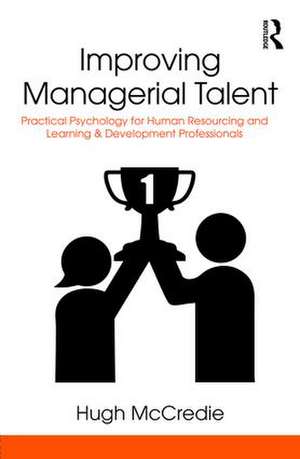Improving Managerial Talent: Practical Psychology for Human Resourcing and Learning & Development Professionals
Autor Hugh McCredieen Limba Engleză Hardback – 27 noi 2017
The book provides the reader with some self-insights and an appreciation of validated, powerful, often in-house, methods for selecting and developing better managers. The methods on offer have been validated on a population of over 400 directors of small to medium-sized business units. They include a generic psychometric algorithm for the selection of managers, some unique findings on styles of managing, coaching and persuading based upon close observation of over 200 senior managers and a distinctive and powerful approach to developing interpersonal skills by (1) practice, (2) demonstration of alternatives and (3) reflection.
| Toate formatele și edițiile | Preț | Express |
|---|---|---|
| Paperback (1) | 313.60 lei 6-8 săpt. | |
| Taylor & Francis – 31 mar 2021 | 313.60 lei 6-8 săpt. | |
| Hardback (1) | 762.58 lei 6-8 săpt. | |
| Taylor & Francis – 27 noi 2017 | 762.58 lei 6-8 săpt. |
Preț: 762.58 lei
Preț vechi: 1101.85 lei
-31% Nou
Puncte Express: 1144
Preț estimativ în valută:
145.91€ • 152.36$ • 120.49£
145.91€ • 152.36$ • 120.49£
Carte tipărită la comandă
Livrare economică 15-29 aprilie
Preluare comenzi: 021 569.72.76
Specificații
ISBN-13: 9781138559202
ISBN-10: 1138559202
Pagini: 154
Ilustrații: 35 Line drawings, black and white; 22 Tables, black and white
Dimensiuni: 156 x 234 x 16 mm
Greutate: 0.36 kg
Ediția:1
Editura: Taylor & Francis
Colecția Routledge
Locul publicării:Oxford, United Kingdom
ISBN-10: 1138559202
Pagini: 154
Ilustrații: 35 Line drawings, black and white; 22 Tables, black and white
Dimensiuni: 156 x 234 x 16 mm
Greutate: 0.36 kg
Ediția:1
Editura: Taylor & Francis
Colecția Routledge
Locul publicării:Oxford, United Kingdom
Public țintă
Postgraduate, Professional, and Professional Practice & DevelopmentCuprins
Introduction; PART I: RECOGNISING AND SELECTING MANAGERIAL TALENT; Section 1. What contributes to overall managerial performance?; A suggested model; Section 2. What type of evidence will be considered?; Mental abilities, personality traits and personal competencies of average and high performing managers; Section 3. Mental abilities and personality traits; An overview of general mental ability and the Big Five personality traits and how these are distributed across the general population; Section 4. General mental ability; Do managers need to be intelligent?; Section 5. Extraversion; Do managers need to be extraverted?; Section 6. Agreeableness; Do managers need to be agreeable?; Section 7. Extraversion and Agreeableness in combination: Possible risks; Section 8. Conscientiousness; Do managers need to be conscientious?; Section 9. Agreeableness and Conscientiousness in combination: Possible risks; Section 10. Neuroticism (aka Emotional variability) or Stability?; Do managers need to be stable?; Section 11. Extraversion and Emotional variability in combination: Possible risks; Section 12. Openness; Do managers need to be open-minded?; Section 13. Summarising the mental ability and personality of managers; Including differences amongst the key business functions; Section 14. Harnessing personality and IQ test scores to guide selection; A worked example; Section 15. Recognising potentially dysfunctional personalities; A need for caution; Section 16. Leadership and personality: A review of research; Section 17. Is personality stable or ‘plastic’?; Accept it or change it?; Section 18. Moving on to personal competencies; Sixteen competencies into four common competency clusters; Section 19. Competency clusters and overall managerial performance; Some impressive connections; Section 20 . Drawing the threads together; Intelligence, personality, competencies and overall performance. Do we need to measure the first two if we have competency ratings?; Section 21. Performance in Key result areas; The missing link between competency and overall performance. The assessment domain most familiar to line managers; PART II: BEHAVIOURS AND STYLES; Section 22. Management behaviours; The interactive behavioural habits of average and high performing managers; Section 23. Behavioural styles; Telling or asking?; PART III: DEVELOPING MANAGERIAL TALENT; Section 24. Developing managerial talent; An overview; Section 25. Coaching around competencies; A performance coaching process based on a practice-demonstration-reflection learning design model; Section 26. Coaching for interpersonal competencies: Briefing; With a worked example; Section 27. Coaching for interpersonal competencies: Reviewing; With a worked example; Section 28. Developing line manager coaching skills; An outline approach and difficulties addressed; Section 29. Using contrasting ask/tell styles to develop interpersonal competency; Telling and asking styles; Section 30. Quick coaching; With a worked example; Section 31. High intensity training in influencing and persuasion; Based on the practice-demonstration-reflection learning design model; Section 32. The ‘win-win’ perspective; A strategic approach to influencing and persuasion; PART IV: IMPROVING MANAGERIAL TALENT: Reflections and Summary; Section 33. Is management right for you?; Useful to know when seeking to recognise, select and develop managerial talent in others; Section 34. How to recognise potential, select and help develop effective managers; A final summary and conclusion; Notes; Bibliography; Appendix; Index
Descriere
Aimed at senior HRM and L&D specialists responsible for improving their organisation’s managerial talent, the book covers the core findings of the author’s and other published research. It provides a highly participative overview of personality and ability psychometrics, involving the opportunity for self-application. It reveals hard evidence of the extent to which such tests can add value to the prediction of managerial success and their link to requisite competencies. It shows how qualified testers, HR and line managers can each make a unique contribution to the selection process.
